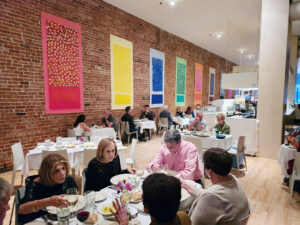Blood brothers — art and surprise
11/5/2025
Lucca as a pop up gallery.
Last month, Steve Logsdon turned the sesquicentennial architecture of his Lucca café into evidence of a personal awakening. Two years ago, Logsdon told us it would be absurd to put art on his restaurant’s brick walls. In October, he covered the walls, upstairs and down, with more than 50 supersized paintings from a collection of “hundreds of them.”
All the paintings were by one artist — Logsdon. All have been painted in a little more than one year. We call the artist’s inspiration an awakening because that’s easier for us to comprehend than an obsession. The paintings are not just a middle-aged crazy’s midlife panic. They are so brilliant that Italian design companies are interested in them, they are selling briskly and Steven Vail is representing Logsdon. Vail is a Des Moines gallery owner who also represents Chuck Close’s estate and deals mostly in art investments for coastal brokers.
The one-night event was a rare pop-up moment for the Des Moines art scene. It was likely the best-attended gallery opening of the year. There was a raffle, an auction and a crowd that included many of the best dressed, and a few of the worst dressed, people in town.
It was also a reminder of the good works of the late architect Kurt Blunck. Lucca was one of the treasures he rescued from the wrecking balls of powerful people who wanted to tear it down. It is now one of the jewels in East Village’s revival — and one of a few great restaurants in town. Nothing has showed off its splendor better than that evening.

Des Moines Symphony excels at discovery.
The Des Moines Symphony’s (DMSO) season opener was another surprising moment of the city’s art scene. Maestro Joe Giunta explained that it originated because COVID shutdowns provided him with “an abundance of time to listen to new music.” His serendipitous discovery then was young Asian American composer Viet Cuong and his collaborations with Chicago sextet Eighth Blackbird (EB).
Cuong appeared with the symphony and told the audience that music saved him from an unhappy childhood of not fitting in with his contemporaries. EB doesn’t fit in with other classical sextets — they are composed of flute, clarinet, piano, percussion, violin and cello. They are named after a little-known poem of Wallace Stevens, and they have won four Grammys and a MacArthur Award.
Their collaboration on “Vital Sines” was commissioned by the U.S. Navy Band. For this concert, Giunta provided pairs of flutes, oboes, bassoons and clarinets, three each trumpets and trombones, four horns, plus a tuba, glockenspiel, timpani, chimes, triangle, China cymbal, bass drum and crotales plus his usual strings.
The performances inspired the most enthusiastic audience reception we recall for a piece other than “Beethoven’s Ninth” or “Tchaikovsky’s 1812.” It was performed before intermission. The crowd increased noticeably after intermission, obviously for Tchaikovsky’s popular Fifth. Those who showed up late missed the kind of things that Giunta brings to Des Moines — discovery and surprise.
Moberg Gallery provided a discovery for Des Moines gallery goers in October with a show by self-described “Romantic nostalgist” Georgi Andonov. The artist is a Bulgarian star. His obsession with the subject matter of queens reminds us of Freddy Mercury, who named his band Queen because “there is nothing more outrageous than the Queen.”
Andonov did a show on Bulgarian national TV dressed in a performance jump suit from Des Moines’ outrageous rockers Slipknot. In his artist statement, he explained, “I am driven to render familiar images and present them to the viewer in their most extreme form.” Freddy would get that. ♦
Touts
Des Moines’ most celebrated living artist, b. Robert Moore, returns to his hometown for a November show at Moberg. “In Living Color” promises to “reimagine the iconic cartoons I grew up with… brown like me, brown like us.”
DMSO’s November concerts match Arnold’s “Four Scottish Dances” and Bruch’s “Scottish Fantasy” with Beethoven’s “Eroica,” frequently called “the beginning of Romanticism.”
Brooklyn Museum’s ”Monet and Venice” is probably the best reviewed exhibition of the New York year. It plays through February and includes additional Venice lovers — Whistler, Singer Sargent and J.M.W. Turner.











